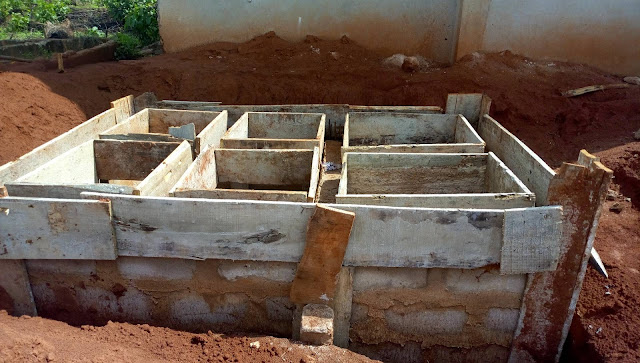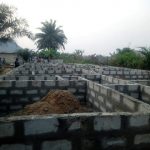Today on guardianconstructors.com i am going to be talking a lot about septic tanks. I will be discussing what this word means because i have seen a lot of people design septic tanks in the name of soak away, i have also seen people design these wrongly without considering several factors.
 |
Approach View of a Sandcrete Septic Tank still Under construction
PhotoCredits MrPinner |
What is a Septic Tank?
A Septic tank is a special liquid waste management structure constructed to help collect domestic solid waste, separate the sludge which settles at the bottom, the Effluent which is a clear water and located at the middle of the compartment and then lastly the scum which comprises of oils, floating solids that settles at the top of the effluent
A Septic tank is usually made with Sandcrete Blocks (Common in Africa) or sometimes with concrete depending on what the water table of the area is like.
There also exists Precast concrete septic tanks which are commonly found in other parts of the world like Unites states, United Kingdom, Germany, etc.
Types Of Septic Tanks In Nigeria
(Based On Material Used For Construction)
Concrete Septic tanks are usually common in the riverine areas of Nigeria especially areas where the water table is so close to the surface.
Sandcrete Septic Tanks are common in areas where the water table is located at a considerable depth. This is common in the uplands, Northern part Of Nigeria, Eastern Nigeria and other parts with less water bodies.
Please Note: Sandcrete means Blocks
How Does A Septic Work?
The thing is that the septic tank collects all forms of wastes from the home. These includes liquid wastes from the kitchen, bathroom. When these gets into the septic tank, they gradually settle into different layers within the septic tank.
Layers Of Effluents On Septic Tanks
Now lets consider the layers these wastes divide into the very moment they get into a septic tank but to do this, we must bring in the cross section of a septic tank as it would help us have a better understanding of what is talked about here.
Based on what we can see from the cross section of a septic tank above, Effluents in the septic tanks divides into:
Scum Layer: Now can you see the scum layer? The scum layer is where anything that couldn’t settle below the water finds itself. They gradually float on top of the main liquid. The scum layer is the very first layer you’ll see if ever you open the septic tank for maintenance of to empty its content.
I Have actually attached a video link for anyone that would love to get a better idea on how septic tanks work. It is a video course created by WWMSOS and titled A Guide to Septic System Maintenance
Also See: The Roles Of A Site Engineer
Sludge Layer: The sludge layer is where all heavy materials settle. These materials are heavier than water and thus the bottom of the tank is their resting place.
Hope you can see the sludge layer at the very bottom? On complete removal of all liquid from the septic tank, the sludge is what would be left. The sludge is usually thick in nature.
Effluent: Water is usually found below the scum layer. This is the middle layer in the septic tank. Effluent section of the septic tank is usually characterized by fowl smelling water and contain a lot of bacteria as well as chemicals such as phosphorus and nitrogen which are very necessary for the degradation of the sludge
From the Outlet Baffle, a part of the effluent is disposed by being flushed into the drain fields where they are sent to the ground by perforated drain pipes. On sending these effluents to the soil, soil bacteria acts and converts the wastes to useful nutrients such as ammonia, nitrogen which is then utilized by plants in the field
The chemical content of the water contained in a septic tank is often the main reason why the water is usually used as fertilizer.
Now you have learnt a few about the septic tank, what if you share this with others to also widen their scope about septic tanks?
Yes you can share by using any of the social media Icons below or besides this page
Other 5 Interesting Topics




Hello! This post could not be wrotten any better!
Reading this post reminds me of my previous room mate!
He always kept chatting about this. I will forward this post to him.
Pretty sure he will have a good read. Many thanks for sharing!
Hi just wanted to gife you a quick heads up aand let you know a few of the pictures aren't
loading correctly. I'm not sure why but I tgink its a linking issue.
I've tried it in two different web browsers and both show the same
results.